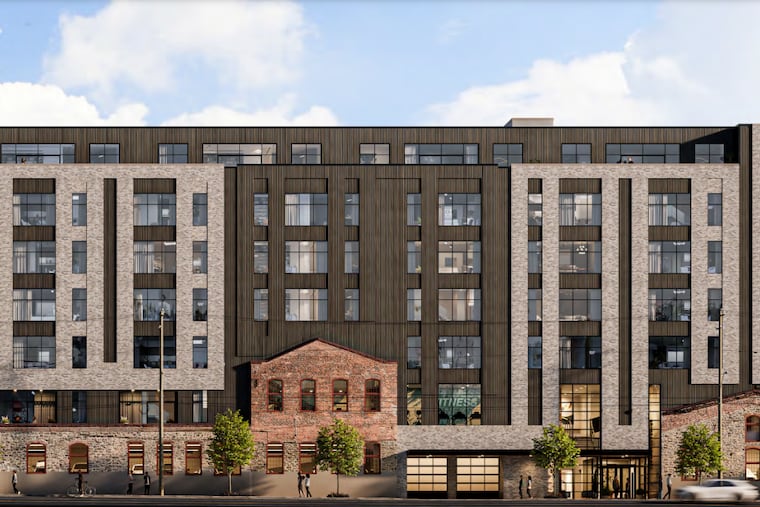The last textile mill in Manayunk could be razed for a 167-unit apartment building
A battle is brewing over whether an apartment building can be built in Manayunk's historic district.

What does the future hold for 10 flood-prone historically protected industrial buildings on Main Street in Manayunk?
This month, the Philadelphia Historical Commission’s advisory committees have been weighing a proposal to replace the former textile facility at 4045-61 Main St. with a seven-story, 167-unit apartment building.
“We would like nothing more than to pursue more preservation at this location,” said Eric Leighton, a principal with CBP Architects, who designed the apartment proposal for developer Urban Conversions. “It’s just not possible.”
Their proposed building would offer 160 parking spaces on the first two floors, lifting the apartments out of the floodplain, and would offer a mix of studio, one-bedroom, and two-bedroom apartments. It would preserve a handful of the historic facades on Main Street, but the vast majority of the complex would be razed.
The Manayunk Neighborhood Council, the Preservation Alliance of Philadelphia, and the Architectural Committee of the Historical Commission oppose the proposal, arguing that Urban Conversion has not made an ironclad case for the demolition of the historic structures.
They acknowledge that the complex will have to change but say that more of the existing buildings can be reused. The proposed apartment building is also far larger and taller than anything else on Main Street, and opponents say it violates the historic character of the district and multiple zoning rules for the site.
“The site offers an opportunity for creative redevelopment incorporating some of these significant historic buildings,” said Hanna Stark, director of policy and communications for the Preservation Alliance of Greater Philadelphia.
On Tuesday, the Historical Commission’s Architectural Committee recommended against approving the demolition of the existing site and of the proposed apartment building. But on April 3, the Historical Commission’s Committee of Financial Hardship ruled in the developer’s favor.
Next, the full Historical Commission will have to consider both committees’ recommendations and make a final ruling.
The last remnant of Manayunk textile industry
Manayunk was once a hub of textile manufacturing, and 4045-61 Main St. was home to the last operation in the neighborhood.
The Littlewood family owned and operated a textile dyeing mill at this site from the 1860s onward, even as the rest of the industry shriveled. But in 2021, G.J. Littlewood & Son was forced to close its doors after flooding from Hurricane Ida inundated the property.
“Members of the Littlewood family had to flee their offices out the upper windows of the factory, jumping roof to roof to flee the flood waters,” according to notes from the Financial Hardship Committee’s meeting.
The certainty of future floods at the site, which the development team says is in one of the lowest points in Manayunk’s historic district, means the existing structures cannot be reused and that new construction must be elevated out of the floodplain.
To move forward with the proposal, which places its residential units out of the path of flood waters, Urban Conversions must make the case that there is no economically feasible way to reuse the existing historic buildings.
“Even if you could find someone who wants it to do that [put it to industrial use again], you would have a very difficult time finding someone to pay for it,” said Peter Angelides, president of Econsult Solutions, a Philadelphia consultant on economics, real estate, and public policy, which is working for Urban Conversions. “This is not ideal industrial land anymore.”
Angelides added that Econsult’s study showed the existing complex is not reusable as hotel, office, residential, or restaurant space.
Looking ahead
Both Urban Conversions and CBP Architects argue that their firms have deep histories with adaptive reuse of historic structures and that if there was a way to move forward without demolishing most of the properties, they would do it.
“We have an awareness of what makes adaptive reuse viable and do not see these characteristics in this property,” Leighton, with CBP Architects, said in a letter included in the demolition petition to the Historical Commission.
Opponents of the Urban Conversions proposal say that the developer hasn’t made the case that a huge apartment building is the best use for the site, especially when it requires razing almost all of the historic buildings.
“If it’s so impossible and impractical to put any sort of commercial use on the site because of frequent flooding, why is the best solution to pack it full of people and cars,” Kevin Smith, president of the Manayunk Neighborhood Council, wrote in a letter to the Historical Commission.
To move forward, the full Historical Commission will need to consider and approve the demolition plan and the new apartment proposal’s design. They could do so as soon as next month.
Editor’s note: This story has been updated to correct the names of Hurricane Ida and G.J. Littlewood & Son.